“Wup, wup, wup” (Cartoon)
.
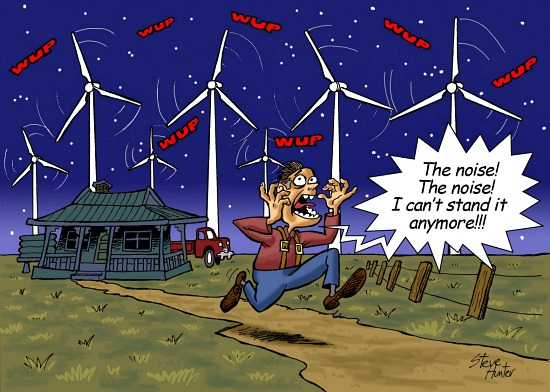 With appreciation to Steve Hunter
With appreciation to Steve Hunter
.
 With appreciation to Steve Hunter
With appreciation to Steve Hunter
Editor’s note: Most readers of this site are familiar with the wind industry’s misuse of infrasound: The industry at first claimed there was zero infrasound coming from their turbines. When they could no longer cover their genitals with that preposterous fig leaf, they went on to hire a fool who made himself famous brazenly declaring that, though there was infrasound, it was so insignificant as to be irrelevant. When that fig leaf was likewise blown away by empirical evidence, they retreated to the pathetic argument, “Well, hell! If people are getting sick, it’s their own damn fault! They’re making it up!” And so it goes.
Of course, the military industrial crowd has been jerking off over infrasonic weaponry (“acoustic weapons”) for decades. Do a Google search to find titillating reading of varying degrees of credibility.
Now (see “Police Use Military Megaphone,” below) New York City cops are using it. But, like Big Wind, they’re pretending they’re not. And the manufacturer of this diabolical toy (“military megaphone” my ass!) is being just as coy. The issue is not so much what the cochlea “hears,” but the sound pressure that messes up the vestibular organs—the sound pressure that, as others have put it, “kills us softly with its torture.” Or not so softly, depending on intensity, duration of exposure, and pulse of the infrasound.
Read on. The New York Civil Liberties Union, by the way, has been hornswoggled. This $35K weapon is not about “communication”; it’s about torture.
 Karen Piper, PhD, Dept of English, Univ of Missouri
Karen Piper, PhD, Dept of English, Univ of Missouri
.
Read Professor Karen Piper’s experience with this same device. The following is taken from Piper v. City of Pittsburgh, US District Court for the Western District of Penn., Case 2:11-cv-01215-MPK, filed 09/21/11.
24. When the LRAD was activated, Plaintiff suffered immediate pain in her ears, and she became nauseous and dizzy. She developed a severe headache. She was forced to sit down and was unable to walk.
25. When the LRAD was activated, Plaintiff was an innocent bystander and was lawfully and properly exercising her rights and privileges to be on or about the streets and sidewalks of the City of Pittsburgh.
40. As a foreseeable and direct result of the actions of Defendants John Does No. 1, No. 2, No. 3 and No. 4 as described above, Plaintiff suffered injuries including permanent nerve hearing loss; tinnitus; barotrauma [trauma from intense pressure changes, typically in the inner ear and lungs—this is what bats die from when they encounter wind turbines—”exploding lungs”]; left ear pain and fluid drainage; headaches; dizziness; nausea; and physical pain and suffering. Plaintiff suffered the violation of her Constitutional rights as described in Paragraph 38 above.
41. Some of the aforesaid injuries may be permanent in nature and Plaintiff may be forced to submit to medical and medicinal treatment and to expend sums of money for doctors, medicines and other items in the future.
42. All of the above actions by Defendants John Does No. 1, No. 2, No. 3 and No. 4 were purposeful, malicious, arbitrary, capricious, irrational, reckless, wanton, without justification and outrageous, and they reflected a conscious and deliberate indifference to the needs and safety of Plaintiff. Said actions shock the conscience.
Dr. Piper experienced immediate and intense Wind Turbine Syndrome—without the turbines.
—Rocco Parascandola & Tracy Connor, NY Daily News (11/18/11)
The New York Police Department’s (NYPD) anti-protest arsenal includes an amplifier developed for the military — but it’s being used as a loudspeaker, not a “sound cannon” to break up crowds.
“Powerful megaphone awaits marchers,” reads the caption. Bullshit! An infrasonic weapon awaits them! (Photo, courtesy of Todd Maisel/New York Daily News.)
It’s called a Long Range Acoustical Device (LRAD) and it has the ability to blast a small area with 110 decibels of sound — the equivalent of a power saw at close range.
But police officials say that’s not how it’s being used at Zuccotti Park and other protest sites, where it functions as the world’s clearest megaphone.
“We don’t use it to disrupt. We don’t use it as some horrible noisemaker,” said Police Department spokesman Paul Browne.
“We set it up away from where a crowd is. We create a 50-foot safety zone. It sends out a clear, uniform message that can be heard for several blocks.”
The California company that invented the device says it was developed after the bombing of the USS Cole in Yemen in 2000 so naval ships could communicate with anyone approaching.
The system sends out a highly magnified beam of sound in much the way a lens focuses a beam of light.
The company is loathe to say it can be used as a weapon or discuss the potential physical effects of being bombarded with ear-splitting noise at close range.
“Can your car horn be used as a weapon? Can you play loud noise with the LRAD? Absolutely,” said Scott Stuckey, vice president of business development.
“They could cover their ears if it’s too loud.”
Critics say the devices have the potential for misuse by civilian agencies and can cause hearing loss, headaches or nausea.
The New York Civil Liberties Union said the $35,000 devices should only be used for communication purposes.
“It clearly can be used to disperse people,” said Christopher Dunn, associate legal director. “They cause physical pain to make people move.”
He said the group has received no reports of the NYPD using either of its two LRADs as a weapon.
“Making announcements that people can hear is always good,” he said. “Using a sonic cannon to disperse people is not.”
Editor’s note: The following document arrived in my Inbox the other day. Sent from an outfit in Australia, I believe. A group calling itself Windburst Publishing. I don’t know who they are (a Google search turns up nothing), yet a careful reading of their document and cover letter tells me their material is sound and intelligent, and worth posting. Windburst’s email is shown at the end of the cover letter, if you want to contact them.
.
 .
.
Substantial progress has been made recently in the fight to relegate wind turbines to their proper place in the generation of power. However, it has to be acknowledged that health problems are still being caused by operating projects and will be certain to arise through the construction of projects approved under outdated, ill informed and inequitable guidelines.
Success in public exposure of the manifold negatives of wind is such that objectors now have a unique opportunity, perhaps worldwide, to tell the politicians and the developers what country residents will tolerate; otherwise there will be a permanent political campaign to enforce these demands and to show that governments are being negligent in their duty to preserve the environment , ensure the health and well being of all their citizens and provide for secure affordable energy supplies in the future.
Accordingly Windburst Publishing has commissioned the preparation of the attached document “Universal Rules for the Public Approval of Wind Energy Projects.”
The “Rules” are meant to address the matters that are common to virtually any onshore wind project and for that purpose do not engage in matters or problems that may be very important in a specific location. It is Windburst’s hope that these rules can, with local parameters separately addressed, be pushed on democratic governments all around the world wherever this useless and dangerous technology is viewed as an essential part of saving the planet.
Clearly by adopting common rules more pressure can be exerted on individual administrations. Here is the first issue of the Rules, it will be updated as required.
.
Windburst Publishing
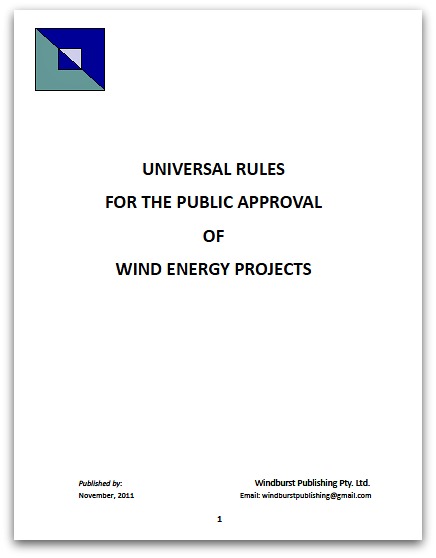 Click here to access this file (PDF)
Click here to access this file (PDF)
Editor’s note: The “Occupy Wall Street” movement has something to offer communities being stalked by Wall Street-financed wind developers. Protest! WTS.com urges people in towns like Fairhaven (Mass.) to occupy the sites being brutalized by the Big Wind bullies. We applaud the efforts at “occupation” by people protesting the Lowell, Vermont, wind project.
Take a page from a pissed off Eskimo elder, Esther Green, who occupied the Yukon River while fishing it. (Or was it the Kuskokwim, below the Yukon?) Esther, like many Eskimos, is deeply vexed and wounded by the exploitation of her homeland—the place of the animal beings and human beings known as the Yup’ik, “Raven’s People.” (I wrote a book about living with Yup’ik Eskimos, published with Yale University Press, “The Way of the Human Being.” Nina & I lived on the tundra for two years, when Nina was a doc up by the Bering Sea.)
Read the story of Esther’s one-woman Occupy Alaska movement, below. For more on this, click here.
Yup’ik Elder Esther Green and I went out on the river at her request. She instructed me to post this photo of her ‘Occupying the River.’ She also would like to include the sloughs, streams, brooks, and ocean. She wanted to be a part of the Occupy movement in her own way, while ice fishing for ‘lush fish.’ She does not want Pebble Mine or Donlin Creek mine ‘bothering the fish’ (in her words) and is worried about the impact those mines will have on the fish. She specifically told me to post it so ‘The Occupy Wall Street people can see it.’
Update 11/14/11: Tonight I called Esther to read her the comments. There are another large number of comments at the FaceBook page, so I read her those, too.
Mulling all of this over she said, ‘You know, I saw all of this on the news and then your picture went everywhere. I remembered “find your spot, occupy it.” And I thought about how I occupy all of Alaska—but that was too big, too general. I wanted to narrow it down, and I thought of the river. That’s it! I found my spot. Water! On the other side of the world there is water. Everything is connected with water. When are we going out again?’
 Jennifer Kailukiak, Toksook Bay, AK (Courtesy of John Kailukiak)
Jennifer Kailukiak, Toksook Bay, AK (Courtesy of John Kailukiak)
—Reprinted from the website, Fox Islands Wind Neighbors: The truth about living near Vinalhaven wind turbines
One of the arguments of wind turbine advocates on Vinalhaven, Maine, is that noise is all around us. Just get used to it, they tell the turbine neighbors. The entire community was swept up, at first, by the public relations mantra that “the sound of the turbines would be masked by the wind moving through the trees.”
Controversy ensued as soon as the turbines were switched on in 2009. From that time, a protracted legal battle to measure wind turbine noise violations has engaged neighbors and the local utility that refuses to share its data, forcing neighbors to a costly effort to document turbine noise according to state regulations that they discovered, belatedly, were never designed to accommodate the complexity of wind turbine noise. As a result, neighbors of wind turbines are made victims not just of bad economics, benefiting investors, bad community relations, but also of the State that turns a blind eye to unwilling sacrifices by neighbors.
While critics shrug off these issues, neighbors also victimized by the complexity of acoustics related to wind turbines.
Most technical standards for wind turbine noise misplace an egregious fact: the formula averaging decibels levels (called the A weighted scale) was designed to avoid what wind turbine lobbyists knew to be its Achilles heel: low frequency noise that is barely perceptible to the human ear.
Fox Islands Wind Neighbors retained one of the nation’s foremost acoustic experts on wind turbine noise, Rick James, early in the dispute process. This summer, James and co-author Wade Bray presented a paper [wherein they explain the wind industry’s Achilles heel], “Dynamic measurements of wind turbine acoustic signals employing sound quality engineering methods considering the time and frequency sensitivities of human perception.” Presented at NOISE-CON 2011, Portland, Oregon, July 25-27, 2011.
Unless you live with wind turbine noise, it is difficult to appreciate the cost that these industrial machines impose on a rural landscape: it is not just the grinding noise of the turbines or the blade swoosh that plagues neighbors. The worst of it is the low frequencies that are not even captured by current wind turbine standards.
The wind industry knows this and fiercely resists a full cost accounting.
Editor’s comment: In case you’re wondering what’s driving the whole wind energy mania, here’s your answer. My brother, a Chicago lawyer, once advised me to “follow the money” when looking for answers to questions like this. Lipton & Krauss have followed the “clean energy” money—and it turns out it’s being taken out of your pocket.
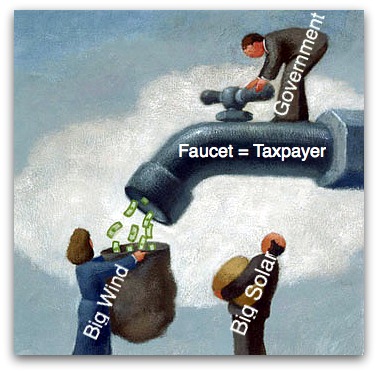 This image was not part of the original article—Editor
This image was not part of the original article—Editor
.
—Eric Lipton & Clifford Krauss, “A Gold Rush of Subsidies in the Search for Clean Energy,” NY Times (11/11/11)
Halfway between Los Angeles and San Francisco, on a former cattle ranch and gypsum mine, NRG Energy is building an engineering marvel: a compound of nearly a million solar panels that will produce enough electricity to power about 100,000 homes.
The project is also a marvel in another, less obvious way: Taxpayers and ratepayers are providing subsidies worth almost as much as the entire $1.6 billion cost of the project. Similar subsidy packages have been given to 15 other solar- and wind-power electric plants since 2009.
The government support — which includes loan guarantees, cash grants and contracts that require electric customers to pay higher rates — largely eliminated the risk to the private investors and almost guaranteed them large profits for years to come. The beneficiaries include financial firms like Goldman Sachs and Morgan Stanley, conglomerates like General Electric, utilities like Exelon and NRG — even Google.
.
Click here to read the remainder of this article . . .

Press Release
10/25/11
Senator John Madigan
(Australia Federal Senate)
.
Questioning of the Department of Health and Aging during Senate Estimates last week cast great doubt over the legitimacy of positioning wind farms in rural areas and the wind energy conglomerates which recommended them.
The National Health and Medical Research Council (NHMRC) was questioned about its decision to wait to correct its statement “There is currently no published scientific evidence to positively link wind turbines with adverse health effects,” to the public until May 2012.
Senator Madigan said the council’s lack of urgency on matters of public health was nothing short of abuse. “The Government is knowingly doing harm to its citizens by ignoring recent findings. This is against public policy.”
“There is plenty of published scientific evidence and recent health reports that link industrial wind turbines and the serious health effects of living too close to them. This evidence is being ignored as it does not sit with the current political agenda.”
“I personally know it has terrible health effects. I have people coming to my electoral office who are suffering the effects of wind farms being too close to their homes. They are in tears, distraught and feel that their health is simply being ignored.”
“Residents have had wind farms built too close to their homes and as a result have had to leave their properties to protect their health.”
“These wind farms are destroying the lives and the health of so many Australians—lives the government has a duty to protect.”
“It should not be up to members of the public who have been driven out of house and home to prove to the Government that wind farms are making them ill. The onus should be on the multimillion dollar companies to prove that there are no adverse health effects.”
“Serious health concerns were raised by health professionals in submissions to the Senate Inquiry into the Social and Economic Impact of Rural wind Farms.”
“It appears the overwhelming majority of submissions to the inquiry were simply ignored. The inquiry received more than 1000 submissions and made only seven recommendations—none of which have seen the light of day.”
“The next time the Senate sits I will be demanding for either that inquiry to be re-opened, or another inquiry opened to look at the health and safety impacts of these wind farms.”

Senator John Madigan:
A man in high public office with integrity, common sense, and balls!
DLP Victoria
Canberra: Suite S1.24, Parliament House, Canberra. TEL: 02 6277 3473
Electorate office: 17 Albert St, Ballarat Vic 3350. TEL: 03 5331 2321
Editor’s note: The following letter is worth reading. By a Cornell professor. He puts his finger on the blatant lies of corporations, denying the harm caused by their products or activities—be the product Agent Orange or the hideous procedure known as “hydro-fracking” (“fracking”) for natural gas.
Everyone with brains and a conscience and a modicum of logic should be absolutely outraged over “fracking”!
Professor Sawyer has written about it in the Cornell University Daily Sun because “fracking,” folks, is coming to Ithaca, NY.
If you know nothing about fracking, start here. Then browse the Internet, including YouTube. Also, see the award winning movie, “Gasland.”
Lastly, get on Google and find a map of the Marcellus Shale, beneath the Appalachians and even beyond. This is where they’re drilling down into. Now find a map for the Utica Shale, beneath the Marcellus and bigger yet. They’re going after this, as well.
Now go turn on your kitchen faucet and kiss your safe water goodbye.
(By the way, fracking has been used out west, in the SW in particular, for years—with disastrous consequences conveniently covered up and lied about by Big Fracking.)
The narrative you are about to read, below, could be applied almost verbatim to Big Wind’s mendacity. To Big Wind’s so-called reports and studies about health effects from wind turbines. Just as Professor Sawyer suggests that people scrutinize the credentials of the so-called experts vouching for Big Fracking, I urge you to check carefully into the credentials and connections of Big Wind’s scientists—the physicians and physicists and acousticians. You will be unpleasantly surprised.
.
—Professor Paul Sawyer, Dept of English, Cornell University, in the Cornell Daily Sun (11/7/11)
How would it feel if, every time a person checked your driving speed, they saw two odometers that said opposite things, one of which was created deliberately to confuse them and risk their life? That’s like the situation faced by the American public today in regards to news on the environment, including the debate over hydrofracking.
The corporate disinformation machine has become so ubiquitous that virtually any news item on environmental risks produces an attack by an industry front group.
As a recent example, The Sun reported that an ILR study has found that the Keystone XL Pipeline will actually reduce American jobs instead of creating them. The same article quoted a blogger for ChamberPost, the blog of the American Chamber of Congress, that disputed the numbers used in the study, adding in a sneer: “Apparently math is not a specialty at Cornell.”
Fortunately, some readers will know that the American Chamber of Congress advocates for controversial industrial projects like the pipeline, and they’ll know that every word of the blog will be false or misleading. Still, The Sun felt obligated to include ChamberPost as a legitimate source of opinion — which is a mark of the disinformation campaign’s success.
But what about attacks on independent research that appear to come from independent sources and not from front groups whose job is to misinform?
Earlier this month, The Sun ran a letter denying that there are any credible risks to fracking. Among other things, the writer claimed that since only one case of contamination has occurred “among millions of wells developed in sixty years,” we must not “let ourselves be paralyzed by one-in-a-billion odds. We must act now or retreat to the caves with solar and wind power.”
If true, this would be extraordinary news for Ithaca residents and for Cornell, which has the right to lease up to 11,000 acres to oil and gas drilling.
But it’s not true. As for the single case of contamination, another letter on the same page correctly points out that property owners have to sign non-disclosure statements before leasing their property for fracking — so there may be many cases of contamination that cannot be legally spoken of, despite First Amendment rights.
The writer also ignores research by Cornell scientists Anthony Ingraffea and Robert Howarth, which points to the catastrophic effects of methane gas release into the atmosphere — a virtually inevitable result of hydraulic fracturing.
As for returning us to the days of the cave man, solar and wind power may, in the opinion of many independent researcher, be the only safe option. In short, the letter reads like standard corporate-funded blarney.
But here’s the twist: the author was Dr. Gilbert Ross ’68, Medical Director of The American Council on Science and Health. A Cornellian, a doctor and a group with “science” and “health” in the name: surely an unimpeachable source.
So what is ACSH? When it was founded in 1978, the president described the Center as a non-profit, pro-consumer organization doing independent research on issues of public health.
Oddly, all the Center’s “scientific” work arrived at conclusions counter to those of all other consumer advocacy groups and to the prevailing scientific consensus on topics related to public health. For example, its reports denied any link between high cholesterol levels and risk of heart attack (meaning you can eat as much junk food and sugar-enriched food as you like without worry); its report on cancer rates exonerated chemicals in the environment as a possible factor in the disease; its report on air pollution found that current levels pose no threat to health and that existing air quality controls are unnecessarily stringent; its report on 2,4,5-T (a component of Agent Orange) denied there was evidence of “any convincing relationship between the traditional use” of the herbicide “and adverse health effects in humans.” And much more.
Curious about findings like these, the well-respected Center for Science in the Public Interest reviewed the research of ACSH; its 70-page report, “Voodoo Science, Twisted Consumerism” (1992) found that the reports were seriously flawed (in some cases “shocking” and “stunning” in their omissions and errors) and that the reports’ conclusions always favored the interests of the corporations that contributed to the group.
These sponsors included Frito-Lay, Oscar Meyer, Hershey Foods and other producers of “junk food”; companies like Bethlehem Steel, Consolidated Edison and Texas Utilities, all of which have been cited by the EPA for air pollution violations; and of course Dow Chemical and Monsanto, which manufactured Agent Orange.
Since then, the Center has become notorious for its positions (including the claim that DDT is not toxic to humans) — to the extent that The Daily Show with Jon Stewart did a send-up of its founder in 2010.
In order to grasp fully how despicable ACSH is: The false statements about the component of Agent Orange appeared at a time when thousands of Vietnam Vets, poisoned when the US government sprayed the herbicide on the forests of Vietnam, were struggling in court to receive compensation from the Federal Government. (The effects on the Vietnamese were and remain one of the major public health catastrophes of the twentieth century. An estimated 500,000 Vietnamese children have birth defects resulting from their parents’ exposure to the deadly herbicide.)
The important point to grasp is that ACSH’s claims do not result from unconscious bias, or from poor judgment in its choice of sponsors, or from good intentions, or simply from shoddy work. Simply put, ACSH earns its money by lying for corporations; it has no other function. No wonder it hasn’t disclosed a list of funders since 1992. In 1991, however, the group’s list of contributors included Mobil and Shell.
Its stance on fracking is therefore unsurprising.
ACSH isn’t important as simply another example of corporate mendacity; it’s far more important as the symptom of a grave national crisis, one that (not to be too obvious about it) may very well determine the fate of the earth.
Though nobody is perfect, the only reliable way of predicting and controlling the future of our planet is through research conducted by the scientific method, independently of ideological or financial inducement — research of the sort that has made campuses like Cornell distinguished in the nation.
Yet the largest effect of the corporation disinformation machine — including the politicians who are also on the payroll, like the so-called “global warming skeptics” in Congress — is to confuse the public, not just about specific issues like fracking, but about the methods and integrity of science itself.
They get away with it, most importantly, by the collusion of the mainstream media. It’s an outrage that well-known prevaricators can appear over and over on TV and in editorial pages to “debate” their “points of view” side by side with credible experts and genuine consumer advocates.
Yet most viewers are poorly protected from this sanctioned sabotage of crucial knowledge — which amounts to the denial of a fundamental democratic right.
Article 19 of the Universal Declaration of Human Rights — the freedom of speech section — states in part: “Everyone has the right . . . to seek, receive and impart information through any media and regardless of frontiers.” It follows that citizens have the right to the most accurate and reliable knowledge available to them as citizens so that they can make informed judgments. Above all, they have the right to knowledge crucially affecting their health, safety, and well-being of themselves and their children.
They get away with it because of another reason: the silence of institutions powerful and credible enough to challenge them — including universities like Cornell, which has so far failed to speak out against irresponsible attacks on its own researchers.
So who is Dr. Ross? When he was hired by the founder of ACSH, he had just served over a year in federal prison for medical fraud, with an added count of obstruction of justice. (The details of scam appeared in an article in Mother Jones entitled “Calling Dr. Ross.”)
In short, Dr. Ross simply moved from defrauding the government of New York to defrauding the American public — legally, and for bigger bucks.
—Anthony Watts, Watts up with That? (4/28/11). Editor’s comment: The following text is adapted from Watts’s note.
I got wind of this photo, below, via the Wakey Wakey thread.
 Photographer Christian Steiness. The above photograph shows the turbulence field behind the Horns Rev 1 offshore wind turbines. Unique meteorological conditions on 12 February 2008 at 1300 hours resulted in the wind turbines creating condensation (i.e. clouds) of the very humid air, thus making it possible to see the turbulence pattern behind the wind turbines.
Photographer Christian Steiness. The above photograph shows the turbulence field behind the Horns Rev 1 offshore wind turbines. Unique meteorological conditions on 12 February 2008 at 1300 hours resulted in the wind turbines creating condensation (i.e. clouds) of the very humid air, thus making it possible to see the turbulence pattern behind the wind turbines.
The above photo appears to be a real world effect of the turbulence model, below.
It seems the turbulence caused by the wind turbines can be a catalyst for cloud formation.
·
Comment by Willem Post (MS Mechanical Engineering): “The air, with a relative humidity close to its condensation point, is cooled by the wind turbine as it removes energy from the air. The result is cloud formation many miles downstream of the wind turbines.”
 This image was not in the original article—Editor
This image was not in the original article—Editor
.
—Geoffrey Lean, The Telegraph (UK), 11/5/11
No other pollutant ruins nearly as many lives in Britain and other industrialised countries as noise—and it is the only one known to drive sufferers to murder—yet few receive so little public attention. Green pressure groups, so vocal on so many environmental threats, are almost universally silent about it. Virtually no governments, anywhere in the world, seem to be prepared to give the case for comprehensive action much of a hearing.
Yet two thirds of Europeans—450 million people—are exposed every day to noise levels that the World Health Organisation (WHO) says are unacceptable. In Britain, more than half a million people appear to move home every year to escape the din. Ten years ago, a survey found that 12 million of us were disturbed by traffic, 3.5 million by passing aircraft, and 11 million by noisy neighbours. This is bound to have got worse: household noise complaints have risen five-fold over the past two decades.
Of course, we have been surrounded by sound since before birth—the womb is quite a noisy place—and noise pollution is as old as civilisation. Two and a half thousand years ago, Buddhist scriptures recorded the “10 great noises” of contemporary cities as “elephants, horses, chariots, drums, tabors, lutes, songs, cymbols, gongs and people crying ‘Eat ye, and drink!.’” Just over 100 years ago, a “plague of city noises” described in New York was not far different: “horse-drawn vehicles, pedlars, musicians, animals and bells”.
Within a few decades, this changed; the 10 most annoying noises identified in a New York survey in 1929 all emanated from machines, and since then the automated cacophony has escalated. Particularly disturbing—as a new book by one of Britain’s leading environmental campaigners, John Stewart, points out—is the low-frequency noise produced by aircraft, wind turbines and many household appliances such as washing machines and air conditioners. “The rise and rise of low-frequency noise,” he writes in Why Noise Matters, “is part of the reason for the growing number of noise complaints.”
But only part. More people say they hate piped music in shops, restaurants and public buildings than like it. Noisy neighbours occasionally provoke their victims to kill them. And while some endure—or even seem to enjoy—noise, about one in 10 people are particularly sensitive to it.
Hearing and health suffer. One in every eight American youngsters, aged six to 19, has been found to have noise-related hearing loss, while Stewart predicts: “Within a decade or two, the iPod in the ear could be replaced with the hearing aid.” Learning can be affected. A study in a Manhattan school found that children in classrooms beside a busy train track recorded reading scores 11 months behind their counterparts on the quiet side of the building. When measures were taken to reduce the noise, they caught up.
Noise also raises blood pressure and increases heart rates, especially at night, leading to cardiovascular and other diseases, as well as affecting sleep. The WHO calculated this year that Europeans collectively lose at least a million years of healthy living as a result.
Wildlife, which relies on sound to communicate, is affected too. It’s most obvious in the oceans, where underwater noise is estimated to have doubled each decade over the past 50 years—shipping has grown, oil and gas prospectors use loud blasts from “airguns” to scope the sea bed, and navies increasingly rely on sonar. Whole populations of whales and dolphins—which often use much the same frequencies—are potentially threatened, and fish catches have fallen. And noise on land disrupts intricate ecosystems of sound, where different species divide the acoustic spectrum between them so that they do not interfere with each other’s communication.
Many of the solutions are known: traffic noise could be cut by 70 per cent; shipping could be made much quieter; good insulation in homes could reduce neighbour noise; and piped music could be simply turned off. Indeed, on Tuesday, the Noise Abatement Society will hand out awards to pioneering British councils. But, Stewart reports, only two governments—China and Hong Kong—have undertaken comprehensive programmes.
In Britain, if anything, political interest has waned. The Labour government repeatedly promised to publish a consultation document on a national noise strategy, but never did so. Three years ago, the Lords passed a Bill to restrict piped music, but it was not taken up in the Commons. And the EU’s record is little better: it has neither carried out a comprehensive assessment of what the hazard costs people and society, nor set targets for its reduction—as it has with, for example, air pollution. One way or another, it is time to make a lot more noise about noise.
Laurel Mountain Wind Project Bird Kill
.
—Laura Jackson, President, Save Our Allegheny Ridges.
The massive bird kill at the Laurel Mountain wind facility near Elkins, West Virginia in early October is another example of tragic environmental consequences caused by industrial wind development.
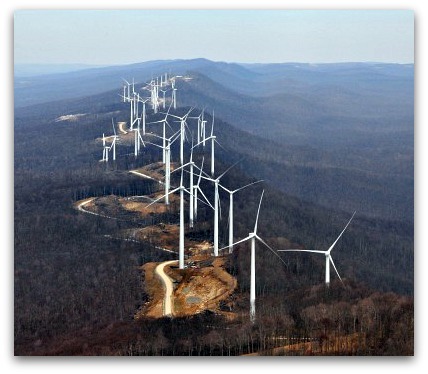 Laurel Mountain windplant, W. Va.
Laurel Mountain windplant, W. Va.
The American Bird Conservancy reported on October 28, 2011 that almost 500 birds were “reportedly killed after lights were left on at an electrical substation.” That report was confirmed when Stantec Consulting Services Inc. reported to the U.S. Fish and Wildlife Service that 8, 250-watt high pressure sodium lamps were left on at the Battery Energy Storage System at the Leadsville substation, part of the AES Laurel Mountain wind facility.
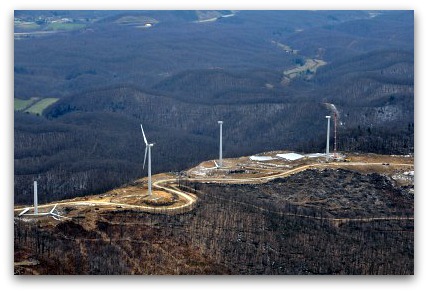 Laurel Mountain windplant, W. Va.
Laurel Mountain windplant, W. Va.
AES staff found a significant number of dead birds on October 3, 2011 that appeared to be fresh kills. The weather over the weekend of October 1 and 2 was poor—high winds, low clouds, thick fog, and cold temperatures.
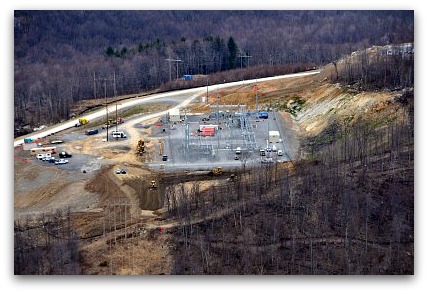 Leadsville substation, Laurel Mountain windplant
Leadsville substation, Laurel Mountain windplant
The Leadsville substation was built as part of the wind project, and is located at a high elevation in a largely forested area. It is presumed that low visibility weather conditions kept the migrating birds flying low over the ridge. When they encountered the lighted substation, it’s theorized they became disoriented and flew into the substation structures, which caused mortality.
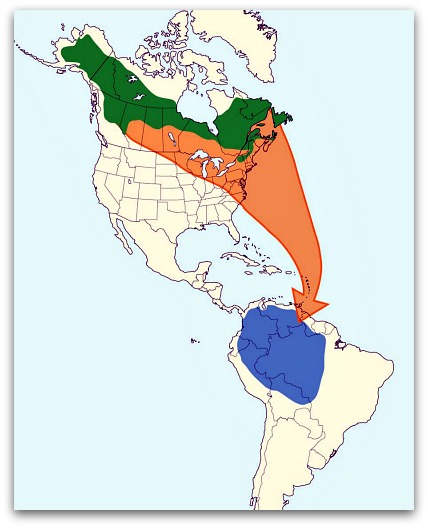 Blackpoll warbler fall migration route
Blackpoll warbler fall migration route
According to the Stantec report, a total of 484 dead birds were collected at the substation during searches between October 3 and 18, 2011. Searchers found 310 dead blackpoll warblers and over a dozen other different species of warblers. A sora, ruffed grouse, Virginia rail, and pied-billed grebe were also killed, as well as 9 unidentified birds.
 Blackpoll warbler, spring plumage (With thanks to Bryan Pfeiffer, Wings Photography)
Blackpoll warbler, spring plumage (With thanks to Bryan Pfeiffer, Wings Photography)
(Fortunately, no bat carcasses were found, and no multiple-fatality events caused by turbines were reported.)
Three issues need to be understood: The first deals with negligence on the part of the Laurel Mountain wind project personnel. Kerlinger and Curry documented a multiple-fatality event of 33 birds at the Mountaineer wind project in 2003 and stated that lights should never be left on at night. (Click here for their report.) Other biologists have reported on bird kills caused by low visibility, high elevations, and lighting.
The Laurel Mountain wind developer should admit that this bird kill was due to gross negligence and should pay a substantial fine. A substantial fine would send a message to other developers that negligence is costly to both birds and wind companies.
The second issue deals with mountain top development—be it caused by industrial wind, coal mining, or drilling for Marcellus shale gas. Our forested ridges in the northeast are important migratory routes for thousands of birds and bats both spring and fall. Industrial development should not be permitted on the migratory ridges. The United States Fish and Wildlife Service (USFWS) recognizes this, but has not developed any mandatory regulations to protect our forested ridges. Voluntary guidelines do not offer any substantial protection and should be replaced with enforced regulations.
The third issue is one of monitoring and reporting. AES staff found significant numbers of dead birds on October 3, 2011, and reported their find to Stantec staff, who reported the mortality to West Virginia Division of Natural Resources (DNR) and to the U.S. Fish and Wildlife Service (USFWS) by telephone on the afternoon of October 3. There is a long history of wind developers hiding data behind claims of “proprietary information” and refusing to divulge facts to the public. Fortunately, this was not the case at the Laurel Mountain substation, since the USFWS has released Stantec’s report. We have asked the USFWS to report the details of this event on their website, in a similar manner to the announcement that an Indiana bat was killed recently at the North Allegheny wind project in Pennsylvania.
Low cloud cover and fog are common events on our mountains and were not problems for migrating birds and bats until human development transformed our forested mountains into industrial development areas. It is clear that lighting should be regulated, so tragedies like the Laurel Mountain bird kill do not occur again.
From: Eric Bibler
To: Falmouth Town Manager, Falmouth Select Board & Falmouth Board of Health
Date: October 31, 2011
Regarding: Your cruel and inhumane wind turbines
.
Please see the anguished plea, attached, of Falmouth resident Sue Hobart. (A copy was forwarded to me.)
As you will note, Ms. Hobart has also included a copy of a similar written plea to your board that she sent nearly a year ago, on December 30, 2010.
As you may know, thousands of people from all over Cape Cod, Massachusetts and the world are watching Falmouth to see if there will ever come a time when you take action to alleviate the suffering you have imposed on your own residents.
As all know, the Town of Falmouth is the developer, owner, operator and chief financial beneficiary of Wind I and Wind II. Wind I and the so-called Webb wind turbine have already brought punishing consequences to residents, and yet the Town of Falmouth expects to begin operation of Wind II as soon as it can obtain the necessary parts.
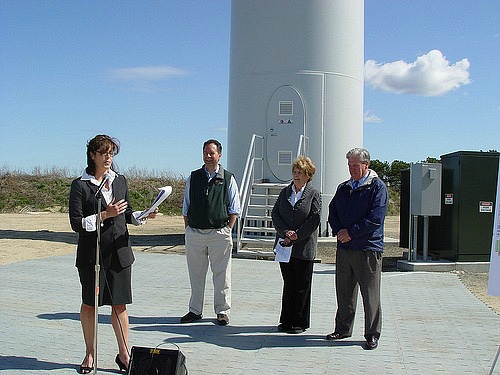 Heather Harper and other dignitaries at the opening of “Wind I”
Heather Harper and other dignitaries at the opening of “Wind I”
I wonder if you can appreciate how baffling it is for people, the world over, to fathom the inaction of your town’s Select Board and, specifically, your callous treatment of your own residents.
As town residents and others who are sympathetic to the plight of the victims look on and try to comprehend your failure to acknowledge their suffering — and your failure to acknowledge that you are the cause of their misery, and that it lies within your power to end their misery, and that, as the developer of a faulty project, it is clearly your responsibility to stop torturing them — the same inevitable questions recur to all of us:
» Do you think your residents are lying to you?
Do you think that they are exaggerating? How else can you possibly ignore their anguished testimonies — and continue to induce such profound suffering — unless you simply don’t believe them? What town, what person, what Select Person could possibly be so callous that he or she would actually BELIEVE what they are telling you, yet shrug his or her shoulders and walk away, saying, “It’s just too expensive to stop torturing you. We can’t afford it.”
How is it possible that any humane person — any responsible civic leader — could fail to accept responsibility for such a mistake? Worse yet, how could any responsible civic leader claim that, even if the town had erred in its estimation that the project would be benign, his responsibility to the fiscal affairs of the town should override the fundamental responsibility not only to provide for the safety of one’s own citizens but, first and foremost, refrain from harming them?
So, again, do you think they are lying to you? How else can you explain your treatment of them — unless you simply don’t believe them?
» If you don’t believe the first-person accounts of your citizens, what basis do you have for doubting them?
How do you know they are lying?
Why do you think they are lying to you — especially since the symptoms they report are identical to the symptoms being reported by thousands of victims all over the world and which have been documented by numerous medical and acoustic experts and which have been reported in thousands of instances in the global press?
What basis do you have for believing that the victims in Falmouth are lying to you? Are they part of a vast global conspiracy? Have they asked you for money? Or have they merely asked you to accept responsibility for your error and to provide them with some relief?
» Are the increasingly desperate pleas from your citizens to their government for relief from this profound disruption to their lives unjust and unwarranted?
Isn’t it true the victims of your industrial project have asked no more of you, as a town government, than to provide them with the bare minimum consideration that any citizen would seem to have the right to expect, namely, that you refrain from threatening their health, from depriving them of sleep, from denying them the rightful use and enjoyment of their property, from severely degrading the quality of their lives, and from destroying the equity in their homes?
Is this an unreasonable request?
Do you believe that, in pleading with you that you show them this minimum consideration, the victims are somehow “blackmailing” the Town of Falmouth?
Do you believe they are lying about these profound adverse impacts for the express purpose of claiming something that doesn’t belong to them?
Do you ignore their pleas because you believe these citizens are seeking to claim something from the Town of Falmouth that they do not deserve?
Conversely, has the Town of Falmouth unjustly appropriated something from these citizens — their safety and their quality of life — which does not belong to the Town?
» If, on the other hand, you do believe the first-person accounts of your own citizens who have repeatedly testified to their suffering — and yet you do nothing to alleviate the suffering — doesn’t this imply that you believe the Town of Falmouth has a right to harm its citizens?
Does Falmouth have a right to harm its citizens — or some of its citizens — or a minority of its citizens — for commercial gain?
If so, what gives you that right?
How many citizens does the Town of Falmouth have the right to sacrifice, “for the greater good,” to avoid taking a loss on this ill-conceived project? Is there a limit? A numerical value?
Do the members of the Select Board accept the notion that these citizens whose lives have been severely compromised constitute the inevitable “collateral damage” from such projects — and that such profound adverse consequences to some number of its citizens are inevitable and justifiable?
At the end of the day, does the Select Board simply subscribe to Lenin’s famous principle that “you have to break a few eggs to make an omelette” — and condone the notion that the victims should simply resign themselves to being the “broken eggs” in the town’s wind energy omelette?
» Why does the Town of Falmouth continue to operate the wind turbines — and continue harming its own residents — even as it professes to search for a way to stop harming them?
How can the Town profess to care about the plight of the victims, and to accept responsibility for the adverse consequences of the project, even as it continues to harm its residents? Why does the Town not stop harming the residents and forego operations until, and unless, it finds a way to operate the wind turbines safely?
—If the Town discovered contamination in some portion of its water supply, would it continue to provide contaminated water to residents while it searched for a solution?
–Would the Town justify continuing to provide the contaminated water on the basis that “it’s just too expensive to provide clean water, rather than contaminated water”?
–Would the town refuse to stop providing the contaminated water on the rationale that “the town just can’t afford to forego the revenues that it receives from the contaminated water”?
–Would the town allow an unsafe bridge to remain open because “it only accommodates ten vehicles” and therefore “will only affect a minority of residents if it collapses” — and it’s “just too expensive” to fix?
–Would the town allow elementary school students to study in a classroom contaminated by asbestos after the problem had been discovered, “because only a fraction of the children in the elementary school are exposed to the asbestos” — and because it’s “just too expensive” to remove this threat to their health?
–Would the Town of Falmouth be sympathetic to the owner of a movie theater or a public auditorium who informed the Town that “it’s just too expensive” to provide an adequate number of exits, or signage, or sprinklers in case of fire?
–Would the Town of Falmouth be sympathetic to a business or homeowner who declared that “it’s just too expensive” to comply with various building codes or provisions for waste disposal or runoff — because any problem “would only affect a minority of people”?
How is it possible — if the leaders in Falmouth don’t believe that citizens are lying to them — that the Town of Falmouth can justify continued operation of a health hazard on the grounds that “it’s just too expensive” to stop hurting people — especially when the Town is not merely creating a hazard that might hurt people, but is actually harming people profoundly, incessantly, relentlessly, on a daily basis?
How is it possible the Town of Falmouth, which would likely show zero tolerance for any of the above threats to citizenry, is willing to condone the evident harm that it’s imposing through the operation of its own commercial wind energy facility?
» Is the Town of Falmouth seeking to accept responsibility for its actions — and seeking to alleviate suffering — or is it merely seeking to justify the imposition of harm and evade legal responsibility for its own actions?
What more definitive and conclusive evidence can the Town of Falmouth ever hope to discover, regarding the potential adverse impacts of these projects, than the first-person reports of the citizenry of Falmouth who are most acutely affected?
What is the point of conducting noise studies, or health studies, unless you doubt the existence of substantial harm; or, more ominously, unless the intent of such studies is to justify the imposition of such harm upon Falmouth’s unfortunate “broken eggs”?
Why is the Town of Falmouth seeking proof of “compliance” with an antiquated and meaningless State noise statute, rather then declaring it unacceptable for the town to be the source of such profound harm, regardless of any “compliance” with an arbitrary statute — unless the intent of the Select Board is to buttress its claim that they have a legal right to impose such harm—because they are “in compliance”?
Why does the Town of Falmouth need a prolonged health study to determine the magnitude of the harm, to compile statistics on the precise number of occurrences of each symptom, their duration, their severity, their cumulative effects, and so forth, when the gross magnitude of the harm is already agonizingly apparent?
Would the Town of Falmouth continue to operate — or refuse to repair — a contaminated water main so that it could spend a year or two studying the precise extent of the health problems that it created — the number of people who were sickened, their symptoms, the duration and severity of their illnesses and the cumulative effects?
If not, why then is the Town of Falmouth so adamant about continuing the operation of its wind turbines — unless it either does not believe the complaints of its citizens (and what person who has witnessed any of these testimonies could fail to believe them), or unless the Town of Falmouth believes it has a right to harm its citizens, and prefers to perfect and protect that “right” by demonstrating compliance with the State noise statutes or making every effort to discredit the health claims?
Is this any way for a town to respond to citizens who come forward to testify that the town is harming them on a daily basis?
» The most fundamental question is this:
Will the Town of Falmouth choose to protect the health and well-being of its citizens and accept responsibility for these ill-advised ventures; or will the Town of Falmouth sacrifice them for the simple fact that they are in the minority, and because there is not sufficient moral character among the members of the Select Board to admit error and choose people over money?
Will the Select Board sell-out some number of its own citizens simply because it’s inconvenient and embarrassing and expensive to acknowledge their claims?
Will the Select Board continue to marginalize the victims for the simple reason that it can — until some court of law or some judge forces it to stop?
All eyes are on the Falmouth Select Board — many more eyes than you could ever imagine. All of them are watching with a sort of horrified fascination, wondering the same thing: When will the members of the Select Board — any members of the Select Board — step forward to “do the right thing”?
Will the members of the Select Board — any members of the Select Board — ever stop the nonsense of avoiding the central question of whether they have the moral character to do the right thing?
For the sake of your long-suffering residents (who have thus far shown the patience of Job), we hope that one day you will do the right thing.